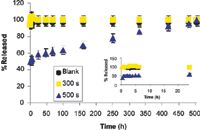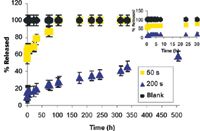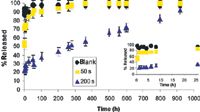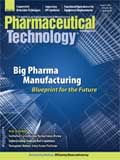Controlled Release from Porous Platforms
The authors present a method for controlling the release of therapeutics by applying a plasma polymer layer to the surface of porous materials.
Advances in nanoscience and nanotechnology have led to the development of novel drug-delivery platforms. During the past decade, attention has focused on nanoporous materials of which the pore size, pore distribution, geometry, and surface functionality can be controlled at the micro- and nanoscale (1–4). For example, porous alumina and porous titanium architectures obtained electrochemically have been proposed for implantable medical devices such as bone implants, vascular stents, and immunoisolation capsules (5–11). The interest in porous materials for therapeutic implants arises not only because of their ability to support tissue integration, but also because they can carry drugs (4, 6). The pores of these materials can be loaded with therapeutic agents and thus act as reservoirs for slow drug elution over extended periods of time, ranging from several days to several weeks (4, 6, 7). The advantages of local therapy through extended release time are high therapeutic concentrations at the target site and minimal systemic exposure (4, 7).
Porous aluminum has been used extensively as a scaffold for bone-tissue engineering applications. The biocompatibility of porous aluminum has been established, and the material has current clinical applications in orthopedic and dental implants (12). Also biocompatible, titanium and its alloys, particularly Ti-6Al-4V, have been used in orthopedic and dental implants extensively since the 1970s (13). It is estimated that more than 500,000 total joint replacements, primarily of hips and knees, and 100,000–300,000 dental implants are provided each year in the United States (13). About 25% of hip-replacement surgeries were undertaken to correct the failure of a previous implant. If an implant is improperly installed, loosening and osteolysis can occur. To overcome this problem, implant bone material should stimulate rapid bone regeneration to fill deficient bones and affix the implant firmly to the bone. The aim of the current research was to engineer bone implants that control and guide rapid healing (12, 13).
In 1994, two large trials demonstrated the superiority of coronary stents over conventional angioplasty in the treatment of coronary artery disease by showing 30% reductions of restenosis rates (14). However, such interventions are associated with major complications. For example, the proliferation of vascular smooth muscle cells (VSMC)can narrow the prosthesis, and endothelial-cell (EC) injury and dysfunction can result in thrombosis. A stent surface that incorporates titanium nanotubes can promote re-endothelialisation and decrease VSMC proliferation (8). Titanium nanotubes improve the proliferation and function of endothelial cells, decrease the proliferation of VSMCs, and enhance the production of prostaglandin I2, which mitigates thrombosis and restenosis (8).
To understand how endothelial cells interact with TiO2 nanostructured surfaces (i.e., how nanotopography affects the morphology of ECs), scientists grew bovine aortic endothelial cells on nanotubular and flat surfaces (8). Cells on nanotubular substrates had elongated morphologies, but cells on the flat surfaces were spread out and covered greater surface areas. Because of the elongation, cells on nanotubes covered 60% of the average area occupied by the control cells. The elongated cells also had increased proliferation and extracellular matrix production when compared with their spread-out counterparts. In addition, elongated cells had higher migration speeds. Since migration into the wound site is a major mode of re-endothelialization, enhanced EC motility may greatly improve healing after injury or device implantation (8).
The encapsulation of living cells (i.e., cellular immunoisolation using semipermeable porous aluminum barriers) has also been investigated in the past several decades as a potential treatment for diseases such as Parkinson's, Alzheimer's and Type I diabetes (11). The encapsulation of living cells is a promising future therapy because immunoprotected cells, such as pancreatic islets or hepatocytes, can respond physiologically both in vitro and in vivo to appropriate stimuli (11).
Scientists have adopted two general strategies to control drug release rate from porous materials. The first strategy relies on the adjustment of pore diameter and pore depth to control drug loading and release (4). The second uses surface functionalization of the pores, which affects drug affinity, and consequently release kinetics (4). However, these strategies have drawbacks. For example, in both strategies, the release kinetics are marked with an initial burst that may not be desirable in some applications. In addition, reducing the pore diameter to extend the length of drug release leads to a reduced pore volume and, consequently, less drug can be stored (6, 7). This article introduces a novel strategy for controlling the release of therapeutics from porous materials and demonstrates its applicability using model antibiotics and a protein.
Experimental protocols
High-purity aluminum foil (99.99 wt %, Alfa Aesar) with a thickness of 100 μm was used to fabricate anodic aluminim oxide (AAO) substrates, according to the published method (15). Aluminum foil was degreased in acetone, sonicated for 30 min, thoroughly rinsed with MilliQ water, and electrochemically anodized using two-step anodization following previously reported procedures (16, 17). The first anodization was performed for 2–4 h under a 60–80 V and an electrolyte temperature of 1 °C in 0.3 M oxalic acid. After the resulting aluminum layer was dissolved, the second anodization was performed as described previously. The anodization conditions were maintained to ensure that all porous layers had the same pore diameters (70–90 nm) and pore thickness (20 μm).
The drugs were loaded through consecutive deposition (20 times) followed by drying under vacuum for 2 h. Release testing was carried out in 5 mL of phosphate buffer (PB) at 37 °C. For each point in drug-release determination, 0.5 mL of medium was removed, diluted by 2.5 mL PB, and spectrophotometrically analyzed for drug content. Withdrawn medium was immediately replaced with 0.5 mL of fresh PB.
Plasma polymerization was carried out in a custom-built reactor described elsewhere using a commercial 13.56-MHz plasma generator (Advanced Energy, 16, 17). The depositions were carried out in an atmosphere of pure allylamine (AA) at a pressure of 0.22 Torr. An input power setting of 20 W was used in combination with a matching network to minimize reflected power. The deposition of AA under these conditions was carried out for 50, 200, and 300 s. The deposition rate was about 0.5 nm/s–1, determined by ellipsometry on polished silicon wafers. Scanning electron microscopy (SEM) images were obtained on a Philips XL 30 FEGSEM.
Results and discussion
Controlling drug release from porous materials. To overcome the drawbacks of current approaches, a strategy for controlling drug release rate from porous materials was developed. The aim was to enable zero-order release kinetics with minimal burst release and without compromising the amount of loaded drug, which is important in long-term therapies (18). At the heart of this strategy is the deposition of a plasma-polymer layer with controlled thickness on top of the porous substratum loaded with a drug. The hypothesis was that the plasma-polymer layer would reduce the pore diameters at the surface, which, in turn, would define the rate of drug release form the pores. Plasma polymers are formed on a substrate from a gas phase when a selected precursor is electrically excited (19). Using plasma polymers for the present drug-delivery platform design has several advantages. Firstly, solvents are not involved because plasma polymers are deposited in the gas phase. Solvents may lead to loss or contamination of the loaded drug. Secondly, the thickness of the plasma polymer overlayer can be controlled with nanometer precision by the plasma-deposition conditions (in this particular study, by deposition time), which is important to establish precise control over release rate. Finally, in this study, plasma polymer films were deposited from vapor of allylamine, which resulted in films rich in amine functional groups. These types of films promote the adhesion and function of biological cells (20, 21).
The authors chose AAO as a model porous platform because it can be prepared by a self-ordering anodization process using simple preparation procedures (15, 16, 20–21). It consists of an array of perpendicular and highly ordered pores with a diameter of 80 nm and a depth of 20 μm. To demonstrate control of drug release rate through this approach, the authors selected common antibiotics and a protein as model compounds of various molecular weights. These items include levofloxacin (MW 370), vankomycin (MW 1449), and bovine serum albumin (BSA, MW 66400). As a last step, an allylamine plasma-polymer film of predetermined thickness was deposited on top of the porous material loaded with drug. The thickness of the deposited film was controlled by the time of deposition, which was 50, 120, 200, and 300 s.

Figure 1: Scanning electron microscope images of the anodic aluminim oxide (AAO) bare surface and (a) AAO modified with allylamine plasma polymer using deposition times of (b) 50 s, (c) 200 s, and (d) 300 s. (ALL FIGURES ARE COURTESY OF THE AUTHORS)
SEM characterization of the porous substrata after plasma-polymer deposition for 0, 50, 200, and 300 s is shown in Figure 1. After plasma deposition, pore diameters decreased from 80–90 nm to < 20 nm. The thickness of plasma-polymer films deposited from the same precursor on plain silicon wafers were measured by ellipsometry as 41 nm, 89 nm, 134 nm, and 200 nm when films were deposited for 50, 120, 200, and 300 s, respectively. However, the thickness measured on plain surfaces can only be used as a guide. Previous reports demonstrated that plasma polymers deposit differently on porous materials (20). Films grow from the rims of the pores and reduce the diameter of the pores at the surface. Importantly, the plasma polymers do not fill the pores, but only deposit at the pore entrance (16).

Figure 2: The influence of plasma polymer coatings on the release profiles of levofloxacin. The legend shows plasma time depositions.
Drug-release kinetics: proof of concept. The drug-release profiles from AAO for samples with and without plasma-polymer film deposited on the surface are presented in Figures 2–4. Increasing the time of deposition (i.e., film thickness) clearly led to slower release for all three model drugs. Release behavior is also a function of drug type. Extended release of levofloxacin (see Figure 2) of three weeks can only be achieved if the plasma deposition time is prolonged to 500 s. In the case of vancomycin (see Figure 3), which has a molecular weight more than three times larger than that of levofloxacin, extended release can be achieved after plasma deposition of only 50 s. A clear correlation between time of deposition and drug release profiles was observed. From uncoated samples, drug is completely released within 45 min. Depositing plasma polymer for 50 s extends the release to about 200 h. Deposition for 200 s further extends the release because only 50% of drug is released after 500 h. Figure 4 shows the release of BSA. As in the case of antibiotics, increasing the time of deposition led to a slower release rate; release could be extended to six weeks when plasma polymer was deposited for 200 s.

Figure 3: The influence of plasma-polymer coatings on the release profiles of vankomycin. The legend shows plasma time depositions.
The release kinetics from plasma-coated platforms can be described in two phases. The initial fast release within the first 45–60 min (see Figures 2–4) can be regarded as a burst, whereas release patterns from 1 h to completed release can be considered controlled release and fit into first- and zero-order models (see Table I, 20–21). The parameters show that zero-order kinetics best account for the experimental data. Furthermore, zero-order release (i.e., constant k0) follows the same rank order as plasma-polymer deposition time. With increasing deposition time, the zero-order release constant decreases exponentially (see Table I). Zero-order release kinetics are a desirable release pattern because a constant amount of drug is released in each time interval (13). Such release kinetics, typical for reservoir transdermal delivery systems, are rarely reported for porous devices (15).

Figure 4: The influence of plasma-polymer coatings on the release profiles of bovine serum albumin. The legend shows plasma time depositions.
The ability to control the release rate of various drugs, including proteins, makes the authors' system a potential platform for the design of various therapeutic implants and drug-delivery devices. The results demonstrate that it is possible to achieve zero-order release kinetics from porous materials through controlled deposition of a plasma-polymer layer. The method for controlled drug release by deposition of a plasma polymer overlayer also could be extended to any type of porous drug carrier because the deposition techniques are independent of the substrate.

Table I: Controlled-release parameters for 1â500 h.
Conclusion
The authors described a method for controlled release of therapeutics from porous materials that has the potential to be applied to various therapeutics and types of porous materials. The method involves the application of a plasma-polymer layer on top of porous materials, and the thickness of this layer controls release kinetics. Athough the current study emphasizes plasma polymerization as a tool to reduce pore diameter at the surface, future work should consider the influence of the plasma polymer's physical properties, such as hydrophilicity, on drug release. The ability of plasma polymerization to provide films of various physical and chemical properties provides enormous flexibility for fine tuning drug-release platforms to suit various drugs and applications.
Spomenka Simovic is a doctor of colloid chemistry and pharmaceutics, Dusan Losic is associate professor of nanostructured materials, and Krasimir Vasilev* is an Australian Future fellow, all at the University of South Australia, Mawson Lakes Campus, 5095 Mawson Lakes, South Australia, fax: +61 8 830 25689, krasimir.vasilev@unisa.edu.au.
*To whom all correspondence should be addressed.
Submitted: Feb. 17, 2011. Accepted: May 13, 2011
References
1. C.T. Kresge et al., Nature 359, 710–712 (1992).
2. J.S. Beck et al., J. Am. Chem. Soc. 114 (27), 10834–10843 (1992).
3. M. Vallet-Regi et al., Chem. Mater. 13 (2), 308–311 (2001).
4. M. Vallet-Regi, F. Balas, and D. Arcos, Angew. Chem. Int. Ed. 46, 7548–7558 (2007).
5. K.C. Popat et al., Biomater. 28 (21), 3188–3197 (2007).
6. M. Vallet-Regi, Chem. Eur. J. 12, 5934–5943 (2006).
7. I. Izquierdo-Barba and M. Vallet-Regi, J. Nanomater. 1, 1–14, (2008).
8. L. Peng et al., Biomater. 30 (7), 1268–1272 (2009).
9. L. Peng et al., Nano Lett. 9 (5), 1932-1936 (2009).
10. K.E. La Flamme et al., Cell Transplant. 16, 765–774 (2007).
11. K.E. La Flamme et al., Biomater. 28 (16), 2638–2645 (2007).
12. E.E. Leary Swan, K.C. Popat, and T.A. Desai, Biomater. 26 (14), 1969–1976 (2005).
13. K.C. Popat et al., Biomater. 26 (22), 4516–4522 (2005).
14. H. Masuda and K. Fukuda, Science 268, 1466–1468 (1995).
15. P. Costa and J. M. Sausa-Lobo, Eur. J. Pharm. Sci. 13 (2), 123–133 (2001).
16. S. Simovic, D. Losic, and K. Vasilev. Chem. Commun. 46, 1317–1319 (2010).
17. K. Vasilev et al., Chem. Commun. 24, 3600–3602 (2009).
18. A.J. Beck et al., Tissue Eng. 7 (4), 441–456 (2003).
19. K. Vasilev et al., Nano Lett. 10 (1), 202–207 (2010).
20. D. Losic et al., Nanotechnol. 19, (2008).
21. F. Balas et al., J. Am. Chem. Soc. 128, 8116–8117 (2006).
Citation: When referring to this article, please cite it as "S. Simovic; D. Losic; K. Vasilev, "Controlled Release from Porous Platforms," Pharmaceutical Technology 35 (8) 68-71(2011)."

Drug Solutions Podcast: A Closer Look at mRNA in Oncology and Vaccines
April 30th 2024In this episode fo the Drug Solutions Podcast, etherna’s vice-president of Technology and Innovation, Stefaan De Koker, discusses the merits and challenges of using mRNA as the foundation for therapeutics in oncology as well as for vaccines.